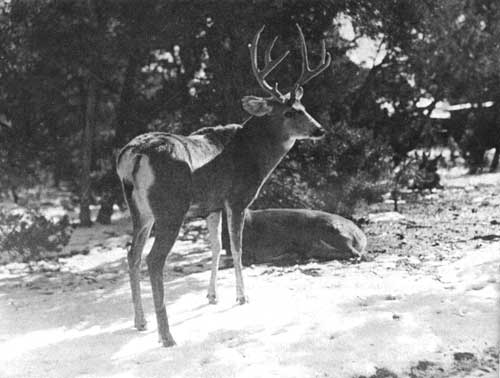|
BANDELIER National Monument |
 |

Mule deer.
Life of the Early People at Bandelier
FOOD. As a practicing farmer, the man's chief reliance for food had been the crops of corn, beans, and squash that he knew how to raise. Perhaps the family had managed to bring some remnants of their most recent harvests with them to Frijoles; but these remnants had to be saved for seed, to insure crops for the coming year. What did the family eat meanwhile? In the warm season, a diet of sorts could have been pieced together by gathering various plants and fruit and nut crops. Spring brought out of the ground several annuals such as the mustard and bee plants which can be boiled for vegetable-greens while young. A bit later the local berry crop came into fruit—currants, gooseberries, chokecherries, and a few raspberries. The ever-present yucca offered its bananalike pod of fruit toward August. When fall arrived, the countryside, in good years, abounded with wild produce: pinyon-nuts and juniper berries, the staples, with trimmings of prickly pears, acorns, and many other seed and nut crops. The ingenuity of the modern Pueblo Indian in coaxing sustenance out of his familiar native plants is extraordinary; very few things that grow are not of some use to him as food or medicine. It may surely be assumed that the Pueblo ancestor of 600 years ago was equally resourceful.
Fortunately, however, this ancient Frijoles resident was not restricted to the collection of wild crops to feed his family. He was a hunter as well as a gatherer. He was armed with bow and arrow, and was undoubtedly an expert shot. Other tools were snares and nets for small game and birds. If he did not bring cordage with him on his migration he promptly wove it from the useful yucca plant, and set out a trapline. Many small animals which moderns would disdain were important food items to the early Pueblos: the once-common prairie dog and the still-common pack rat were eaten in great numbers, if the evidence of bones in ancient trash heaps can be believed. Perhaps only the skunk escaped the designs of the early food-seeker, for a reason which was as valid then as it is today. Of larger animals, the deer was most taken, although elk and antelope were not immune. The remains of game pits, dug into the soft bedrock to entrap larger beasts, have been found in several places in the monument. One of these pits is 15 feet deep with a bottom diameter of 8 feet, narrowing to a smaller bottleneck opening above. The preparation of such a trap as this was obviously a laborious community enterprise, and suggests an occasional community deer-drive to herd the victims across the concealed mouth of the pit.
All this work of hunting and gathering was secondary to planting and tending crops, once the growing season arrived. The Pueblos had discovered, many centuries before, that their best defense against hunger was in growing corn—so the Frijoles hunter became a farmer in late May or June. With digging stick and stone hoe, he prepared the ground to grow his corn, beans, and squash. Not only were the moist canyon bottoms thus cultivated, but also the mesa-tops wherever a sufficient depth of soil had accumulated. This agriculture was not assisted by irrigation systems of any sort that have been discovered here, although irrigation was practiced on the Mesa Verde a century earlier. Apparently the local rains in summer were adequate in Frijoles to bring a crop to maturity. Climatologists believe that there was a little more precipitation over most of the Southwest 500 years ago than there is today, and possibly the ancient corn was more drought-resistant. In any case, in good years the local farmer managed to harvest enough of his three crops in September to tide his family over the privations of winter—if no human marauders descended to loot the granary.
The harvesting of the corn by no means concluded the labors concerned with it. A place of storage safe from rodents was a first requisite, bringing about the building of tight-walled chambers both in the cliffs and in the pueblo understory; then long grinding with stone metate and mano on the part of the housewife was called for to convert the kernels to cornmeal. One ancient use of this cornmeal no doubt is duplicated in the modern Pueblo cooking of Piki—a thin crisp paperlike bread baked on a hot stone griddle. Traces of such griddle-stoves are to be found in some of the ancient pueblos.

|

|
|
Last Modified: Sat, Jan 6 2001 10:00:00 am PDT |


